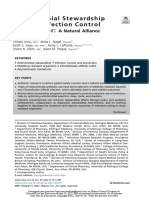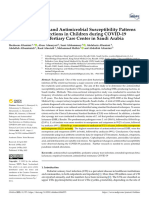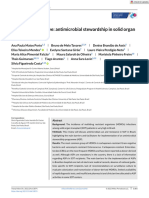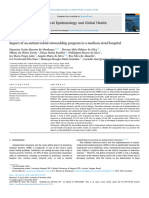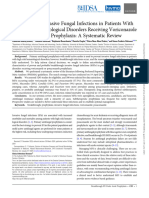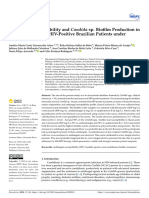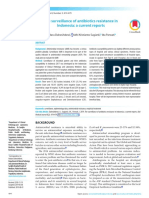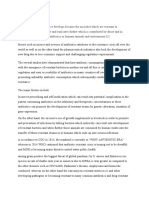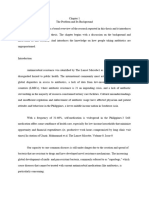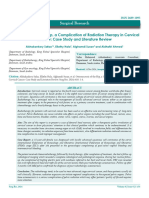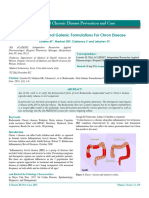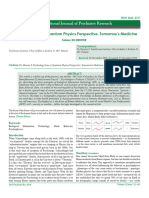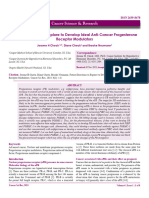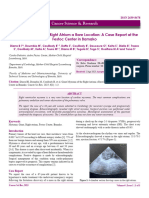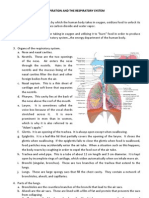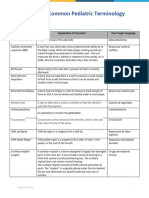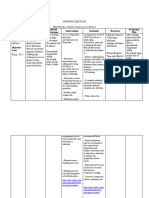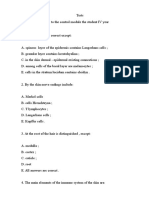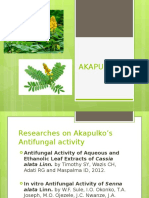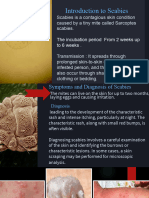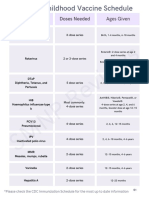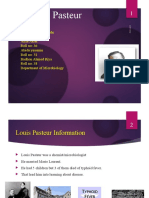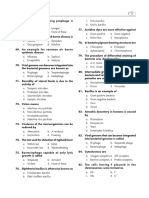Bacterial Ecology and Bacterial Resistance Profile To Antibiotics in The Department of Medicine and Urology of The Bss University
Bacterial Ecology and Bacterial Resistance Profile To Antibiotics in The Department of Medicine and Urology of The Bss University
Uploaded by
Scivision PublishersCopyright:
Available Formats
Bacterial Ecology and Bacterial Resistance Profile To Antibiotics in The Department of Medicine and Urology of The Bss University
Bacterial Ecology and Bacterial Resistance Profile To Antibiotics in The Department of Medicine and Urology of The Bss University
Uploaded by
Scivision PublishersOriginal Title
Copyright
Available Formats
Share this document
Did you find this document useful?
Is this content inappropriate?
Copyright:
Available Formats
Bacterial Ecology and Bacterial Resistance Profile To Antibiotics in The Department of Medicine and Urology of The Bss University
Bacterial Ecology and Bacterial Resistance Profile To Antibiotics in The Department of Medicine and Urology of The Bss University
Uploaded by
Scivision PublishersCopyright:
Available Formats
Research Article ISSN 2639-9458
Microbiology & Infectious Diseases
Bacterial Ecology and Bacterial Resistance Profile to Antibiotics in the
Department of Medicine and Urology of the BSS University Hospital of Kati
Hamsatou CISSE1, Youba SANGARE1, Abdramane TRAORE1, Nagou TOLO1, Amadou KASSOGUE3,
Djeneba DIAGNE1, Cheick Oumar SANOGO2, Boureima KODIO4, Abdoulaye Mamadou TRAORE5,
Garan DABO6, Ghislain PODA7, Brehima GUINDO8 and Daouda Kassoum MINTA5*
1
Department of General Medicine CHU "Professor Bocar Sidy
Sall" of Kati.
2
Traumatology Department CHU "Professor Bocar Sidy Sall"
of Kati.
3
Department of Urology, CHU "CHU Professor Bocar Sidy
Sall" of Kati. *
Correspondence:
Professor. Daouda Kassoum MINTA, Department of Infectious
4
Primum NOCERE Clinic. Diseases, Point G University Hospital, Bamako, Mali, Tel: +223
66844762 /+223 75090209, E-mail: minta_daouda@yahoo.fr.
Department of infectious diseases, CHU du Point G, Bamako,
5
Mali. Received: 07 Jan 2024; Accepted: 15 Feb 2024; Published: 22 Feb 2024
Department of Medicine « CHU « l'hôpital du Mali » Bamako.
6
Mali.
7
National Institute of Public Health, Bamako, Mali.
8
National Institute of Public Health, Bacteriology Laboratory.
Citation: Hamsatou C, Youba S, Abdramane T, et al. Bacterial Ecology and Bacterial Resistance Profile to Antibiotics in the Department
of Medicine and Urology of the BSS University Hospital of Kati. Microbiol Infect Dis. 2024; 8(1): 1-7.
ABSTRACT
Background: The emergence and spread of antibiotic resistance is a major public health threat. Worldwide, one of the main causes
remains the unreasonable use of antibiotics.
Objective: To map bacterial infections and the resistances profile of antibacterials at Kati University Hospital.
Methodology: Transversal analytical study with prospective collection over a period of 20 months in the department of general
medicine and urology of the BSS University Hospital of Kati.
Results: 102 patients participated in this study with an average age of 55.5 years. Almost a quarter (72.5%) of participants were men.
Less than half were patients aged 60 years. The biologics examined involved urine (78.4 %), pus (16%), blood (12.7%), stool (2%)
samples. The main germs isolated were: Escherichia coli (52.9%); Klebsiella pneumonia (14.5%); Staphylococcus aureus (9.9%);
Acinetobacter baumannii and Enteroccocus faecium (4.9%). The level of resistance of Escherichia coli and Klebsiella pneumoniae
was high to ampicillin, amoxicillin-clavulanic acid; cotrimoxazole; moderately elevated to C3G, and fluoroquinolones with relative
sensitivity to aminoglycosides. Imifpenem, Amikacin, Ertapenème were the most active antibiotics. Staphylococci were resistant
to penicillin, with ciprofloxacin and oxacillin. Thus, Acinetobacter baumannii had a high level of resistance to C3G, Ticarcillin,
Cotrimoxazole and Piperacillin-tazobactam. Enteroccocus faecium had strong resistance to Cotrimoxazole and Ciprofloxacin.
Microbiol Infect Dis, 2024 Volume 8 | Issue 1 | 1 of 7
Approximately, 51% of isolated bacteria were multi-resistant. HIV infection; antibiotic therapy; a long stay in a healthcare setting is
a risk of acquiring multidrug resistance. This relationship is statistically significant with a p value of p<0.00respectively 5
Conclusion: The level of resistance recorded should serve as an alert for the implementation and application of prevention strategies
for BMR. The resistance profile determined will be used to better guide the rational prescription of antibiotic therapy in our hospital.
Keywords profile and write the determinants associated with the emergence
Bacterial ecology, Antibacterial resistance profile, CHU BSS Kati. of antibacterial resistance.
Introduction Methodology
The discovery of antibiotics was considered the most important It is analytical cross-sectional study using a prospective collection
and astonishing of the twentieth century. Their introduction into method over a period of 20 months (January 2019 to August2020)
clinical care practice is one of the interventions that has addressed in the Department of General Medicine and urologsurgery within
not only infectious disease control challenges with millions of lives the University Hospital Center “Professor Bocar Sidy Sall" (CHU-
saved but also a revolutionized practice [1]. However, according BSS) by Kati. Our study site is located about fifteen km from the
to the WHO, a serious and growing threat to global health is capital of the country and approved for the care of patients referred
deteriorating the effectiveness of these therapeutic molecules, due from different levels of the country's health pyramid or from those
to the increase in antibiotic resistance in community care settings who have come for routine consultations by personal decision.
and the environment concomitant with their use [2]. This Bacterial
Resistance to Antibiotics, defined here as the ability of bacteria Study Population Characteristics
to survive in concentrations of antibiotics that usually inhibit/ Adult patients admitted to hospitalization following referral from a
kill others of the same species "Antimicrobial resistance may not health facility of lower technical platform level or equivalent level,
seem as urgent as a pandemic, but it is just as dangerous" [3]. The having been exposed to antibiotic therapy or not; or patients who
European Antibiotic Resistance Surveillance Network (EARSS) have made an individual decision of outpatient consultation prior
reports about 50% of Escherichia coli strains were resistant to hospitalization.
to ampicillin in France, as globally in all AERSS participating
countries [4]. Eligibility
Eligibility for the study concerned exhaustively all patients
It affects 500,000 people with suspected bacterial infections in 22 admitted to hospitalization with clinical signs in favor of an
countries and according to the same source, more than 700,000 infectious syndrome who had benefited from a collection of
deaths worldwide result each year from antimicrobial-resistant pathological products for etiological research purposes and whose
infections based on OMS, more than the number of deaths caused bacterial etiology documented is combined with an antibiogram
by cancer by 2050 [5]. over the entire study period.
In the United States, resistance to ATBs is responsible for more Data collection and analysis
than 23,000 deaths and a direct societal cost of $20 billion, and an Data collection is carried out by pre-trained and field-tested survey
indirect cost of $35 billion. It is noted during 400,000 infections personnel. The data is collected on pre-established individual
responsible per year with at least 25,000 deaths [5,6]. records and entered on Access version 2016. The variables studied
include sociodemographic, clinical, biological bacteriological
In Africa, this phenomenon of resistance is poorly evaluated; data variables. The premium IMB SPSS Statistics 21 software was
show a strong spread of multidrug-resistant bacteria in the various used for the analysis. The proportions were compared by the chi-
countries of West Africa [6]. The lack of national epidemiological square test and Fisher's exact test. A p-value ≤ 0.05 was considered
data on Bactriean resistance and of national reference on BMR are a statistically significant difference.
a handicap to the implementation of BMR prevention strategies
[1]. Plot work in the context of the LCRMs reports a high Ethical aspects
frequency of multidrug-resistant enterobacteriaceae among others, The protocol of this study was submitted to the administrative
64.3% of E coli and 34.5% of Klebsiella pneumonia [1,5]. Within managers of the CHU " Professor Bocar Sidy Sall" of Kati. After
other hospitals in the country, ours would not be immune to the approval, patients' voluntary, voluntary and informed consent
emergence of antibacterial resistance. It is necessary to take stock was sought prior to inclusion. All patients have an identification
of the issue of the profile of antibacterial resistance, with regard number that will allow them to remain anonymous. The files are
to abusive and unregulated prescription; The absence of a local closed in a safe and kept for a period of 5 years.
repository; the frequency of invasive procedures and the long stay
of patients in a care setting. Results
Socio-demographic characteristics of participants
Our objective was to do bacterial infectious etiological research of During the study period, we collected 840 hospitalizations, 102
cases; determine the frequency of the current bacterial resistance patients meeting our inclusion criteria or 12.14% of patients. Most
Microbiol Infect Dis, 2024 Volume 8 | Issue 1 | 2 of 7
Figure 1: Sample portion taken.
Figure 2: Distribution by wearing of medical equipment.
Figure 3: Type of germs isolated.
Figure 4: Proportion of different multidrug-resistant bacteria in isolates.
Microbiol Infect Dis, 2024 Volume 8 | Issue 1 | 3 of 7
Table 1: Proportion of germs isolated by body fluids.
Bacterium Blood (%) Urine (%) Stool (%) Pus (%) Total
Escherichia Coli 3 46 1 4 54
Klebsiella pneumoniae 2 12 0 0 14
Staphylococcus aureus 2 4 0 1 7
Streptococcus hemolyticus 2 0 0 0 2
Streptococcus epidermis 1 0 0 0 1
Enterrococcus faecium 0 5 0 0 5
Enterococcus faecalis 0 1 0 0 1
Pseudomonas aerguinosa 0 4 0 0 4
Acinetobacter baumani 0 5 0 0 5
Enterobacter sp 0 2 0 0 2
Morganella morganii 0 1 0 0 1
Salmonella spp 0 0 1 0 1
Proteus mirabilis 0 1 0 0 1
Sphingomonas 0 1 0 0 1
Raoultella ornithinolytica 0 1 0 0 1
Proteus penneri 0 1 0 0 1
Streptoccocus spp 0 0 0 1 1
Total 10 84 2 6 102
Table 2: Profile resistance Escherichia coli to antibacterial. Table 3: Resistance profile of Klebsiella pneumoniae.
Sensitive Resistant Total Sensitive Resistant Total
Antibiotic Antibiotic
n% n% n% n% n% n%
Ampicillin 2 (3,7) 48 (88,9) 50 (92,6) Ampicillin 0 11 (78,6) 11 (78,6)
Amoxi-Ac clavulanic 7 (13) 44 (81,5) 51 (94,5) Amoxi-Ac clavulanic 7 (21,4) 10 (71,4) 13 (92,8)
Ticarcillin 3 (5,6) 39 (72,2) 42 (77,8) Ticarcillin 0 11 (78,6) 11 (78,6)
Piperacillin-Tazobactam 7 (13) 32 (59,3) 39 (72,3) Piperacillin -Tazobactam 3 (21,4) 7 (50) 10 (100)
Cefotaxime 10 (18,5) 39 (72,2) 49 (90,7) Cefotaxime 4 (28,6) 7 (50) 11 (78,6)
Ceftazidime 8 (14,8) 38 (70,4) 46 (85,2) Ceftazidime 3 (21,4) 8 (57,1) 11 (78,6)
Ertapenem 40 (74,1) 5 (9,4) 45 (83,3) Ertapenem 9 (64,3) 1 (7,1) 10 (74,4)
Imipenem 45 (83,3) 2 (3,7) 47 (87) Imipenem 11 (78,4) 2 (14,3) 13 (92,8)
Amikacin 41 (75,9) 9 (16,7) 50 (92,6) Amikacin 12 (85,7) 0 12 (85,7)
Gentamicin 27 (50) 20 (37) 47 (87) Gentamicin 3 (21,4) 8 (57,1) 11 (78,6)
Ciprofloxacin 8 (14,8) 42 (64,6) 50 (92,6) Tobramycin 4 (28,6) 8 (57,1) 12 (85,7)
Ofloxacin 4 (7,4) 40 (74,1) 44 (81,5) Ciprofloxacin 4 (28,6) 10 (74,4) 14 (100)
Ofloxacin 3 (21,4) 9 (64,3) 12 (85,7)
Table 4: Isolation of bacterial resistance by previous exposure to antibiotic therapy.
Risk factors related to bacterial resistance
95% C.I. for EXP (B) P-value
Exp (B) Lower Upper
HIV 10,009 3,644 27,493 ,000
Step
ATB ,214 ,095 ,479 ,000
Constant ,746 ,593
Microbiol Infect Dis, 2024 Volume 8 | Issue 1 | 4 of 7
of our patients were male and aged 60 years and older with a mean The evolution was favorable in patients without BMR carriers, a
of 55.5 years, a standard deviation of 18, 21 years. More than half frequency of 73.1%. The difference was statistically significant
of our study population, or 60.8%, had a notion of prior exposure (P<0.05).
to an antibiotic. The wearing of a noted medical equipment was the
peripheral venous catheter in 98% patient and the bladder soundin Discussion
86% (Figure 1). The emergence of bacterial resistance with different mechanisms
presents a public health problem, as is the case in this study
Sampling process conducted in patients admitted to hospitalization in both
In the 102 subjects collected during the study, the majority departments. The main objective of this study was to investigate
biologics were urine (78.4%), Purulent (16%), blood (12.7%), bacterial infections and the antibiotic resistance profile. During
stool (2%) samples that were tested. the implementation of this study, some limitations were identified,
including:
E coli is the germ most found in both departments with a greater • The difference between susceptibility testing is that the
frequency in the urology department or 53% followed by 14.3% of samples were not processed in the same laboratory.
Klebsiella pneumonia and Staphylococcus aureus in 7% of cases. • Completeness of data.
• The low participation rate due to lack of financial means for
Results of Susceptibility Testing of Priority Germs the realization of biological examinations.
Bacterial resistance to antibacterial antibiotics has increased to
alarming proportions in view of our analysis. Despite these limitations, this study retains its originality, which
Escherichia coli: most E. coli strains had developed stronger lies in its prospective and multi-service nature thus taking a picture
resistance in more than > 60% to ampicillin (88.9%); of the situation of isolated bacteria and their level of sensitivity to
Amoxicillin-clavulanic acid (81.5%); Ofloxacin (74.1%); antibiotics.
Ticarcillin (72.2%). About 40% of the strains were resistant
to Cefotaxime Ceftazidime. Ertapenem, Imipenem Amikacin During our study period, 102 patients meeting our inclusion
remain active on most strains (only 16% resistance recorded criteria or 12.14% of patients were registered. Most of our patients
to amikacin). were male aged 60 years and older with an average age of 55.5
Klebsiella pneumoniae: 74.4% were resistant to Ciprofloxacin years. This predominance of the elderly and the male sex could be
and Tobramycin. All strains tested were sensitive to Amikacin, explained by the fact that 2/3 of our patients were collected in the
7.1% were resistant to Ertapenem and 14.3% to Imopenem. urology department.
Acinetobacter baumannii: The combination piperacillin-
tazobactam, Ceftazidime and Cotrimoxazole were the most Bacterial infection can occur at any age; but it is more common in
resistant molecules at 60% each. They were all sensitive to the elderly because of a decreased immune system, bladder atony,
Amikacin, the lowest resistance rate was with imipenem 20%. and the presence of comorbidities. In an earlier study conducted in
Staphylococcus aureus had developed a higher resistance Bamako, the results showed that the infection was more common in
to Cotrimoxazole with 57.1% and 42.9% resistance to women than in men, so he reports in his observation, that the urinary
benzylpenicillin, ciprofloxacin, oxacillin and gentamicin. tract infection was not related to age but patients aged 60 years and
Enteroccocus spp had developed resistance to vancomycin and older were the most affected with and a frequency of 69.23%. The
erythromycin (20%); amoxi-clavulanic acid, Cotrimoxazole same findings were made in Morocco by Saadoun who in his series
and Ciprofloxacin (40%). also reports that urinary tract infection affects all age groups with a
predominance of the age group of 60 years and over (35%), followed
Multidrug-resistant bacteria (MDR) and associated factors by that between 41-60 years (33%) [7]. Indeed, in the elderly, there
Multidrug-resistant bacteria accounted for 51% of the germs is a decrease in the immune defenses of the urinary tract due to
isolated in our series; ESBL production has been observed in changes in the urinary tract, especially the bladder and genital tract.
Enterobacteriaceae (E. coli and K. pneumoniae). BSLE production These changes vary by gender [8]. Of the 102 samples collected
was isolated from E. coli with a frequency of 73.1% (38 out of during the study period, they were mainly urine samples (78.4%)
54 strains isolated) followed by15;4% of K. pneumoniae Several followed by blood samples (12.7%), purulent samples (6.9%).
determinants or factors including HIV infection (40%), previous Urinary tract infection is the most common bacterial infection in
use of antibiotic therapy (79%) have been identified associated the world. This predominance could be explained using bladder
with the emergence of resistance cases but also the duration of catheters by the majority of our patients (86%). In addition to bladder
hospitalization in a healthcare setting, the average of which was catheterization, almost all of our patients had undergone peripheral
13.32 days. HIV-infected patients are ten times more likely to venous catheterization (98.6%) which would be responsible for a
have antibiotic resistance to [RR 10,009; 95% C.I. 3.644-27.493] probable increase in the rate of bacteraemia. In Morocco, Mortaji
However, we did not find a statistically significant relationship had reported in his series that bronchopulmonary infections occupy
between the use of a bladder catheter and theplacement of a the first place with a rate of 47%; infections related to blood cultures
peripheral venous catheter. (primary or secondary bacteremia from another site e.g. urinary tract
Microbiol Infect Dis, 2024 Volume 8 | Issue 1 | 5 of 7
or catheter) with a rate of about 23%; urinary tract infections with a found a susceptibility to fosfomycin and nitrofurantoin greater
rate of about 16%; infections related to pus and miscellaneous with than 98%, a resistance to cephalosporins less than 5% and a
a rate of about 9%. Note his study took place in an intensive care susceptibility to ciprofloxacin less than 90% but this varied
unit. For genital swabs, there was a low diagnostic orientation and according to age and sex. It ranged from about 85% in women
demand is generally low at the level of national hospitals, which are over 65 to 95% in women aged 15 to 65 and about 82% in men.
the last resort for patients after repeated failures of antibiotic therapy.
Imopenem and Amikacin were the most active molecules on BGN
E coli is the germ most found in both departments (medicine especially E. coli and Klebsiella pneumoniae with a low resistance
and urology) with a greater frequency in the urology department rate (less than 20%). These molecules are less used in therapeutics
explaining its presence in most urine samples in this series or 53% by their cost, their limited accessibility and the rational use of
followed by Klebsiella pneumonia 14.3% and Staphylococcus these molecules is mandatory in order to avoid the emergence
aureus in 7% of cases. Gram-negative bacilli are mainly responsible of carbapenemase-producing E. coli strains. Multidrug-resistant
for urinary tract infections, hence a significant proportion of E coli bacteria are a major public health problem, they accounted for
and Klebsiella pneumoniae in our series. This rate is identical to more than half of the germs isolated in our series or 51%. They
that of Takilt et al. in Algeria in 2014, had found Escherichia coli were mainly dominated by enterobacteriaceae (E. coli and
51.94%, Klebsiella 14.56%, Staphylococcus aureus 2.91% [10]. Klebsiella pneumoniae) producing ESBL respectively Escherichia
In Bamako, Coulibaly reports having isolated mostly in order of coli with a frequency of 73.1% or 38 strains out of 54 isolated
frequency Escherichia coli and Klebsiella pneumoniae in 57.75% strains followed by Klebsiella pneumoniae or 15.4%.
and 22.54% of BGN; a codominance of Staphylococcus aureus and
coagulase-negative Staphylococcus in 27.59% of GC (+) each [11]. In France Chervet reported a prevalence of ESBL-secreting
On the other hand, our figures are lower than those of Saadoun in bacteria at 4.2% among Enterobacteriaceae, 5.1% among
Morocco, which had found E. coli with a frequency of 69% followed Escherichia coli and 3% among Klebsiella sp [7], Our figures are
by Klebsiella spp (18%) [7]. Similarly in Paris, Chervet in his study higher than in the literature with a prevalence of ESBL-secreting
on urinary tract infections in the city, reported that most of the urine E. coli at 1.7% between 2003 and 2006 in the Aresc study [14],
analyzed was therefore positive for Eschericha coli (69.4% in the to 1.2% in 2007-2008 in the Ecosens II study [15] and to 3% in
general population, 74.0% in women and 50.1% in men) [12]. 2011 in the AFORCOPI-Bio study [16] which confirms that the
prevalence of ESBL-secreting E. coli is increasing in community-
Analysis of the susceptibility test revealed that the majority of E. coli acquired urinary tract infections.
strains Coli had a stronger resistance in more than 70% to penicillins
(ampicillin), fluoroquinolones (Ofloxacin, ciprofloxacin) and ESBL-producing Enterobacteriaceae are responsible for most
amoxi cillin-clavulanic acid. This rate is significantly higher than nosocomial infections, as approximately all of our patients had
undergone bladder catheterization and PVC; In addition, we did not
that of Takilt et al in Algeria in 2014, reported resistance to E. coli.
find a statistically significant relationship between the wearing of a
in 13.19% of the Penicillin family, Klebsiella pneumoniae was
bladder catheter, the peripheral venous catheter and the occurrence
resistant to amoxi-clavulanic acid, amoxicillin, and Ofloxacin. On
of resistance. However, several other factors were associated with
the other hand, in his study Staphylococcus aureus was practically
this resistance with a statistically significant relationship p<0.05.
sensitive to all antibiotics tested, except for Ofloxacin. [10],
These include HIV infection which was present in 40%, the notion
Saadoun in Morocco noted resistance of E. coli to amoxicillin in
of antibiotic intake prior to hospitalization in 79% of cases but also
64%, although this molecule is not currently recommended for
the duration of hospitalization.
probabilistic treatment of community urinary tract infections [16],
44% to amoxi cillin-clavulanic acid, 36% to ciprofloxacin [7].
Conclusion
Multi-bacterial resistance appears to be expanding in our
In our study about 50% of the strains of Klebsiella pneumoniae
hospital. A framework for consultation between practitioners
were resistant to the different classes of antibiotics tested (C3G,
and in collaboration with microbiologists would better guide the
Fluoroquinolone, aminoglycosides). This rate is significantly prescriptions of anti-infectives.
lower than that of Saadoun, which had found strains of Klebsiella
pneumoniae resistant to third generation cephalosporins (C3G)
22%, aminoglycosides 27% and Ciprofloxacin 42.7% [7]. The References
increase in resistance of these antibiotics in our study could be 1. Adnane M. Bacterial ecology in intensive care and antibiotic
explained by inappropriate consumption of these molecules, resistance profile [These]. Marrakech (Morocco): Cadi Ayyad
because more than 60% of our patients had a notion of antibiotic University. 2019.
therapy before. 2. Dossim S, Gozo A, Teko-Agbeble K, et al. Bacterial ecology
of the environment and equipment during the different stages
In 2011 in France, the AFORCOPI-Bio study [13] studying the of sterilization in the operating room of the CHU Sylvains
susceptibility of Escherichia coli to quinolones and 3rd generation Olympio in Lomé (Togo): University of Lomé. Rev CAMES
cephalosporins in community-acquired urinary tract infections SANTE. 2017; 5: 2.
Microbiol Infect Dis, 2024 Volume 8 | Issue 1 | 6 of 7
3. Christian Brun-Buisson, Didier Guillemot, Laurence 11. Sahdit Baba Coulibaly. Clinical and bacteriological profile of
Watier. Bacterial resistance to antibiotics: epidemiology and urinary tract infection in the Department of Nephrology and
prospective. 2015; 315. https://www.afis.org/Resistance- hemodialysis of the CHU du Point G. These Med Bamako
bacterienne-aux-antibiotiques-epidemiologie-et-prospective FMOS. 2010; 94.
4. David T Hubert C, Yves P, Jean-Marie D, et al. European 12. Delphine Chervet. Urinary tract infections in the city:
Network for Surveillance of Bacterial Resistance to description of the population and current epidemiology of
Antibiotics (EARS-Net): 2001-2010 result for France and bacterial resistance. PARIS DESCARTES UNIVERSITY.
place for Europe. Thèse Med Paris. 2015; 61.
5. Ouédraogo AS. Prevalence, circulation and characterization 13. De Mouy D, Janvier F, Mérens A, et al. Susceptibility
of multidrug-resistant bacteria in Burkina Faso[theme]. Paris: of Escherichia coli to quinolones and third-generation
University of Montpellier. 2016. cephalosporins in community-acquired urinary tract
6. Handbook on the proper use of antibiotics in Sub-Saharan infections: AFORCOPI-BIO study. 2012; 574.
Africa. 2014; 14-17. 14. Schito GC, Naber KG, Botto H, et al. The ARESC study:
7. Meryem Saadoun. Epidemiology and level of resistance of an international survey on the antimicrobial resistance of
bacteria responsible for urinary tract infections in Beni Mellal. pathogens involved in uncomplicated urinary tract infections.
These Med Marrakech, Morocco. 2020; 78. Int J Antimicrobial Agents. 2009; 34: 40713.
8. Gonick P, Falkner B, Schwartz A, et al. Bacteriuria in the 15. Kahlmeter G, Poulsen HO. Antimicrobial susceptibility of
catheterized patient cystitis or pyelonephritis? JAMA. 1975; Escherichia coli from community-acquired urinary tract
233: 253. infections in Europe: the ECO. SENS study revisited. Int J
Antimicrobial Agents. 2012; 39: 4551.
9. Adnane Mortaji. Bacterial ecology in intensive care and
antibiotic resistance profile. These Med Marrakech, Morocco. 16. De Mouy D, Janvier F, Mérens A, et al. Susceptibility
2019; 127. of Escherichia coli to quinolones and third-generation
cephalosporins in community-acquired urinary tract
10. Takil TN. Epidemiological profile of urinary tract infections
infections: AFORCOPI-BIO study. 2012; 574.
with resistance study of multidrug-resistant bacteria at the
Nedir Mohamed University Hospital in TIZI OUZOU.
MemoryScience Bio Algiers. 2014; 56.
© 2024 Hamsatou CISSE, et al. This article is distributed under the terms of the Creative Commons Attribution 4.0 International License
Microbiol Infect Dis, 2024 Volume 8 | Issue 1 | 7 of 7
You might also like
- The Black Death, The Great Mortality of 1348-1350: A Brief History With DocumentsDocument286 pagesThe Black Death, The Great Mortality of 1348-1350: A Brief History With DocumentsVaena Vulia100% (8)
- STB 212 Theory-1Document60 pagesSTB 212 Theory-1Daniel100% (3)
- Antimicrobial Stewardship and The Infection Control PractitionerDocument17 pagesAntimicrobial Stewardship and The Infection Control Practitionersilvia_guerra_1No ratings yet
- CDC Case Studies in Applied EpidemiologyDocument12 pagesCDC Case Studies in Applied Epidemiologysjab3No ratings yet
- Knowledge, Attitudes, and Practices (KAP) of Healthcare Workers On Viral Hepatitis B and Its Vaccination in 12 Health Establishments in The Centre Region of CameroonDocument8 pagesKnowledge, Attitudes, and Practices (KAP) of Healthcare Workers On Viral Hepatitis B and Its Vaccination in 12 Health Establishments in The Centre Region of CameroonInternational Journal of Innovative Science and Research TechnologyNo ratings yet
- Epidemiology and Antibiotic Resistance of Uropathogenic Bacteria Isolated at Thierno Birahim Ndao Regional Hospital Center in KaffDocument6 pagesEpidemiology and Antibiotic Resistance of Uropathogenic Bacteria Isolated at Thierno Birahim Ndao Regional Hospital Center in KaffScivision PublishersNo ratings yet
- Altamimi Et AlDocument10 pagesAltamimi Et Allitbang.pbperdosri4No ratings yet
- Antibiotics 11 01326 v2Document10 pagesAntibiotics 11 01326 v2hawamasfufahNo ratings yet
- Legba Et Al., 2023Document11 pagesLegba Et Al., 2023victorien.dougnonNo ratings yet
- Microorganisms 10 01856Document26 pagesMicroorganisms 10 01856Heitor JoséNo ratings yet
- Clinical Laboratory Analysis - 2022 - Chinemerem Nwobodo - Antibiotic Resistance The Challenges and Some EmergingDocument10 pagesClinical Laboratory Analysis - 2022 - Chinemerem Nwobodo - Antibiotic Resistance The Challenges and Some EmergingMahrukh khanNo ratings yet
- Effectiveness of Quinolone ProphylaxisDocument15 pagesEffectiveness of Quinolone ProphylaxisDeski MadeNo ratings yet
- Interprofessional CollaboratioDocument16 pagesInterprofessional CollaboratioAnggito AbimanyuNo ratings yet
- Ab Round StewardshipDocument7 pagesAb Round StewardshipbpinsaniNo ratings yet
- Pattern of Researches Done On Antimicrobial Resistance in EthiopiaDocument16 pagesPattern of Researches Done On Antimicrobial Resistance in EthiopiaandualemNo ratings yet
- Sepsis Proposal1Document34 pagesSepsis Proposal1Appiah Peter OforiNo ratings yet
- Advantages of Whole Genome Sequencing in Mitigating The Helicobacter Pylori Antimicrobial Resistance ProblemDocument7 pagesAdvantages of Whole Genome Sequencing in Mitigating The Helicobacter Pylori Antimicrobial Resistance ProblemHtet Lin OoNo ratings yet
- Tackling Antimicrobial Resistance in The COVID-19 PandemicDocument2 pagesTackling Antimicrobial Resistance in The COVID-19 PandemicMarak EnNo ratings yet
- Culture Negative SepsisDocument5 pagesCulture Negative SepsismalvindersahiNo ratings yet
- Epidemiological Profile of Acute Typical Bacterial Pneumonia at The National Reference University Hospital Center of NDjamena Risk Factors and Antibiotic ResistanceDocument13 pagesEpidemiological Profile of Acute Typical Bacterial Pneumonia at The National Reference University Hospital Center of NDjamena Risk Factors and Antibiotic ResistanceAthenaeum Scientific PublishersNo ratings yet
- Antibiogram Final SherifDocument24 pagesAntibiogram Final Sherifmohamedbakry75No ratings yet
- journal.pone.0274423Document13 pagesjournal.pone.0274423seilla manja rahmadinaNo ratings yet
- 991 Ijar-7184Document15 pages991 Ijar-7184Kholifatur RohmaNo ratings yet
- Mayoclinproc 86 2 013 PDFDocument12 pagesMayoclinproc 86 2 013 PDFMagdy Ali ELsherbenyNo ratings yet
- Ciz 1049Document9 pagesCiz 1049Justin WilliemNo ratings yet
- Isolation of Nosocomial Multi-Drug Resistant Gram-Negative Bacteria From Some Benghazi HospitalsDocument18 pagesIsolation of Nosocomial Multi-Drug Resistant Gram-Negative Bacteria From Some Benghazi HospitalsInternational Medical Publisher100% (1)
- Multidrug-Resistant Gram-Negative Bacterial Infections and Associated Factors in A Kenyan Intensive Care Unit A Cross-Sectional StudyDocument11 pagesMultidrug-Resistant Gram-Negative Bacterial Infections and Associated Factors in A Kenyan Intensive Care Unit A Cross-Sectional Studyd4rkgr455No ratings yet
- Antibiotics 10 00152Document15 pagesAntibiotics 10 00152NICOLETANo ratings yet
- When To Stop Antibiotics in The Critically IllDocument13 pagesWhen To Stop Antibiotics in The Critically IllJhoselyn De La Torre OnofreNo ratings yet
- Myae 043Document24 pagesMyae 043bsducsgNo ratings yet
- Antibiotico CovidDocument12 pagesAntibiotico CovidPaul ArtigasNo ratings yet
- Golden Hour CCM Arthur Van Zanten IC1Document3 pagesGolden Hour CCM Arthur Van Zanten IC1Sara NicholsNo ratings yet
- Determinants Impacting The Use of Antibiotics Among Patients Visiting The Dental Clinic at Kampala International University Teaching Hospital in Bushenyi-Ishaka Municipality, WesteDocument15 pagesDeterminants Impacting The Use of Antibiotics Among Patients Visiting The Dental Clinic at Kampala International University Teaching Hospital in Bushenyi-Ishaka Municipality, WesteKIU PUBLICATION AND EXTENSIONNo ratings yet
- Bacteriological Profile and Drug Susceptibility Patterns in Dacryocystitis Patients Attending Gondar University Teaching Hospital, Northwest EthiopiaDocument17 pagesBacteriological Profile and Drug Susceptibility Patterns in Dacryocystitis Patients Attending Gondar University Teaching Hospital, Northwest EthiopiaDaisa RosianaNo ratings yet
- USA2016 - A Single Center Observational Study On ED Clinician Nonadherence To Clinical Practice Guidelines For Treatment of Uncomplicated UTI - 12879 - 2016 - Article - 1972Document9 pagesUSA2016 - A Single Center Observational Study On ED Clinician Nonadherence To Clinical Practice Guidelines For Treatment of Uncomplicated UTI - 12879 - 2016 - Article - 1972jessicapxeNo ratings yet
- Nosocomial Infections and Their Control Strategies: Asian Pacific Journal of Tropical Biomedicine June 2015Document6 pagesNosocomial Infections and Their Control Strategies: Asian Pacific Journal of Tropical Biomedicine June 2015R JNo ratings yet
- 2022 Brazilian Perspective Antimicrobial Stewardship in Solid Organ TransplantDocument6 pages2022 Brazilian Perspective Antimicrobial Stewardship in Solid Organ TransplantInaldoNo ratings yet
- Jiaa 221Document13 pagesJiaa 221AndradaLavricNo ratings yet
- Artigo - SimonizeDocument6 pagesArtigo - Simonizeanapri76No ratings yet
- Highly Effective Against EsblDocument9 pagesHighly Effective Against Esblgaurav rawalNo ratings yet
- Antibiotics 13 00272 With CoverDocument14 pagesAntibiotics 13 00272 With CoverJoe Christopher Olivares LopezNo ratings yet
- 2024 Breakthrough Invasive Fungal Infections in Patients With High-Risk Hematological Disorders RecDocument10 pages2024 Breakthrough Invasive Fungal Infections in Patients With High-Risk Hematological Disorders RecRicardo Diaz LeottauNo ratings yet
- Mi Tiku 2018Document10 pagesMi Tiku 2018irania lubisNo ratings yet
- Alves Et Al 2024 - Biomedicines - Reunião Onemyco 25.03.24Document12 pagesAlves Et Al 2024 - Biomedicines - Reunião Onemyco 25.03.24lehabreeuNo ratings yet
- The Surveillance of Antibiotics Resistance in Indonesia: A Current ReportsDocument6 pagesThe Surveillance of Antibiotics Resistance in Indonesia: A Current ReportsRahmanu ReztaputraNo ratings yet
- Antibiotico en SepsisDocument13 pagesAntibiotico en Sepsismaomed2014No ratings yet
- 2023 The principles of curative antibiotic treatmentsDocument6 pages2023 The principles of curative antibiotic treatmentshamid rahimiNo ratings yet
- Antibiotics 12 00560Document12 pagesAntibiotics 12 00560Rone yefer quezada peñaNo ratings yet
- Amrid SummaryDocument6 pagesAmrid SummaryKiran ZahraNo ratings yet
- Bloodstream Infections in Hospitalized Children: Epidemiology and Antimicrobial SusceptibilitiesDocument4 pagesBloodstream Infections in Hospitalized Children: Epidemiology and Antimicrobial SusceptibilitiesrasioputraNo ratings yet
- The Treasure Called AntibioticsDocument2 pagesThe Treasure Called AntibioticsBenamrane MarwaNo ratings yet
- Evidence-Based Prescription of Antibiotics in Urology: A 5-Year Review of MicrobiologyDocument6 pagesEvidence-Based Prescription of Antibiotics in Urology: A 5-Year Review of MicrobiologynovitalumintusariNo ratings yet
- Biomarcadores en La Sepsis - 2024Document9 pagesBiomarcadores en La Sepsis - 2024drjosefonseca.surgeonNo ratings yet
- Cereus 3Document19 pagesCereus 3Natalia DuqueNo ratings yet
- Prevalence and Antimicrobial Resistance Profile of Pathogens Isolated From Patients With Urine Tract Infections Admitted To A University Hospital in A Medium-Sized Brazilian CityDocument11 pagesPrevalence and Antimicrobial Resistance Profile of Pathogens Isolated From Patients With Urine Tract Infections Admitted To A University Hospital in A Medium-Sized Brazilian CityAna LemesNo ratings yet
- Journal 3Document11 pagesJournal 3margareth silaenNo ratings yet
- 2023 Article 41882Document10 pages2023 Article 41882Célio Silva FilhoNo ratings yet
- Evaluation of Prescribing Patterns of Antibiotics in General Medicine Ward in A Tertiary Care HospitalDocument6 pagesEvaluation of Prescribing Patterns of Antibiotics in General Medicine Ward in A Tertiary Care HospitalEditor IJTSRDNo ratings yet
- Chapter 1Document48 pagesChapter 1placalus nimbusNo ratings yet
- Diagnose of BSIDocument12 pagesDiagnose of BSIWong Chun ShengNo ratings yet
- Optimizing Advanced Therapies in Ulcerative Colitis: Is Your Practice Up to Date? A Focus on Clinical Evidence and Guideline RecommendationsFrom EverandOptimizing Advanced Therapies in Ulcerative Colitis: Is Your Practice Up to Date? A Focus on Clinical Evidence and Guideline RecommendationsNo ratings yet
- Campylobacter Enteritis Unveiled: Exploring Pathogenesis, Treatment, and Novel InterventionsFrom EverandCampylobacter Enteritis Unveiled: Exploring Pathogenesis, Treatment, and Novel InterventionsNo ratings yet
- Rotaviral Enteritis: Unraveling Immunological, Clinical, and Therapeutic DimensionsFrom EverandRotaviral Enteritis: Unraveling Immunological, Clinical, and Therapeutic DimensionsNo ratings yet
- Osteonecrosis of the Hip a Complication of Radiation Therapy in Cervical Cancer Case Study and Literature ReviewDocument4 pagesOsteonecrosis of the Hip a Complication of Radiation Therapy in Cervical Cancer Case Study and Literature ReviewScivision PublishersNo ratings yet
- Evaluation of The Knowledge of Mental Health First Aid Among Workers Manning Sick Bays in Schools in EGOR Local Government Area of Benin City, NigeriaDocument4 pagesEvaluation of The Knowledge of Mental Health First Aid Among Workers Manning Sick Bays in Schools in EGOR Local Government Area of Benin City, NigeriaScivision PublishersNo ratings yet
- Moroccan Medical Students Perspectives of Their Educational Environment Qadi Ayyad UniversityDocument7 pagesMoroccan Medical Students Perspectives of Their Educational Environment Qadi Ayyad UniversityScivision PublishersNo ratings yet
- Obesity an Ideological and Discursive AnalysisDocument7 pagesObesity an Ideological and Discursive AnalysisScivision PublishersNo ratings yet
- Digital Media Engagement Childrens Health and Wellbeing a Divide by Family StructureDocument7 pagesDigital Media Engagement Childrens Health and Wellbeing a Divide by Family StructureScivision PublishersNo ratings yet
- Budesonide –Oral Galenic Formulations For Chron DiseaseDocument6 pagesBudesonide –Oral Galenic Formulations For Chron DiseaseScivision PublishersNo ratings yet
- Neuropsychiatric-Imaging in the Depressed Occipital Lobe with A Suicidal Link and Pharmaco-Psychotherapy Outcome Among Pediatric Age Group and AdolescentsDocument8 pagesNeuropsychiatric-Imaging in the Depressed Occipital Lobe with A Suicidal Link and Pharmaco-Psychotherapy Outcome Among Pediatric Age Group and AdolescentsScivision PublishersNo ratings yet
- Psychology From a Quantum Physics Perspective Tomorrows MedicineDocument5 pagesPsychology From a Quantum Physics Perspective Tomorrows MedicineScivision PublishersNo ratings yet
- A Critical Evaluation of Risk and Protective Factors Influencing the Development and Maintenance of Internalizing Disorders in AdolescentsDocument15 pagesA Critical Evaluation of Risk and Protective Factors Influencing the Development and Maintenance of Internalizing Disorders in AdolescentsScivision PublishersNo ratings yet
- Pupils Perceiving of Greatgrandparent With Dementia a Case StudyDocument2 pagesPupils Perceiving of Greatgrandparent With Dementia a Case StudyScivision PublishersNo ratings yet
- An evaluation of the Training and Education of a Work – Based Learning Programme in a Mental Health Hospital in London: The role of the MatronDocument5 pagesAn evaluation of the Training and Education of a Work – Based Learning Programme in a Mental Health Hospital in London: The role of the MatronScivision PublishersNo ratings yet
- Provide Continuity of Care to Psychotic and Schizophrenic Patients Followed in Chud BorgouDocument5 pagesProvide Continuity of Care to Psychotic and Schizophrenic Patients Followed in Chud BorgouScivision PublishersNo ratings yet
- 3d Ct Cinematic Rendering Transforming Forensic Imaging With Enhanced Visualization for Skeletal Trauma AnalysisDocument5 pages3d Ct Cinematic Rendering Transforming Forensic Imaging With Enhanced Visualization for Skeletal Trauma AnalysisScivision PublishersNo ratings yet
- Neurorehabilitation Recovery Advances Through Cns NeuromodulationDocument4 pagesNeurorehabilitation Recovery Advances Through Cns NeuromodulationScivision PublishersNo ratings yet
- Future Directions To Explore To Develop Ideal Anti-Cancer Progesterone Receptor ModulatorsDocument8 pagesFuture Directions To Explore To Develop Ideal Anti-Cancer Progesterone Receptor ModulatorsScivision PublishersNo ratings yet
- Plasma Cell-Free RNA PD-L1 and Survival With Immune Checkpoint Inhibitor Therapy in Metastatic Non-Small Cell Lung CancerDocument6 pagesPlasma Cell-Free RNA PD-L1 and Survival With Immune Checkpoint Inhibitor Therapy in Metastatic Non-Small Cell Lung CancerScivision PublishersNo ratings yet
- A Rare Case of Squamous Cell Carcinoma Following a Cactus Spine InjuryDocument3 pagesA Rare Case of Squamous Cell Carcinoma Following a Cactus Spine InjuryScivision PublishersNo ratings yet
- Cancer Science & ResearchDocument4 pagesCancer Science & ResearchScivision PublishersNo ratings yet
- Conservative Laparoscopic Surgery Plus Mifepristone For Treating Multifocal Renal Cell CarcinomaDocument4 pagesConservative Laparoscopic Surgery Plus Mifepristone For Treating Multifocal Renal Cell CarcinomaScivision PublishersNo ratings yet
- Trends in Nanocarrier Based Delivery Systems of Methotrexate: Update 2020Document7 pagesTrends in Nanocarrier Based Delivery Systems of Methotrexate: Update 2020Scivision PublishersNo ratings yet
- Giant Myxoma of The Right Atrium A Rare Location: A Case Report at The Festoc Center in BamakoDocument3 pagesGiant Myxoma of The Right Atrium A Rare Location: A Case Report at The Festoc Center in BamakoScivision PublishersNo ratings yet
- Anticancer and Antioxidant Effects of Bioactive Extracts From Monk Fruit (Siraitia Grosvenori) With Potential Clinical ImplicationsDocument10 pagesAnticancer and Antioxidant Effects of Bioactive Extracts From Monk Fruit (Siraitia Grosvenori) With Potential Clinical ImplicationsScivision PublishersNo ratings yet
- Immunohistochemical and Molecular Evaluation of Oncoprotein HER-2 in Women's Breast Cancer in The Republic of CongoDocument9 pagesImmunohistochemical and Molecular Evaluation of Oncoprotein HER-2 in Women's Breast Cancer in The Republic of CongoScivision PublishersNo ratings yet
- Cancer Treatment With OncoshuttleDocument4 pagesCancer Treatment With OncoshuttleScivision PublishersNo ratings yet
- Sarscov2 Neutralizing Antibody Presence in Infected and Vaccinated PatientsDocument6 pagesSarscov2 Neutralizing Antibody Presence in Infected and Vaccinated PatientsScivision PublishersNo ratings yet
- Cancer Science &researchDocument10 pagesCancer Science &researchScivision PublishersNo ratings yet
- Byebyehiv With Thai InnovationDocument7 pagesByebyehiv With Thai InnovationScivision PublishersNo ratings yet
- Impact of Clinicoepimiological Characteristics On The Outcome of Neo Adjuvant Concurrent Chemo Radiation in Locally Advanced Rectal Cancer PatientsDocument9 pagesImpact of Clinicoepimiological Characteristics On The Outcome of Neo Adjuvant Concurrent Chemo Radiation in Locally Advanced Rectal Cancer PatientsScivision PublishersNo ratings yet
- Cancer Science & ResearchDocument7 pagesCancer Science & ResearchScivision PublishersNo ratings yet
- Results of A Multicentric Study of Patients With Multiple Myeloma Treated With Three Different Triplet Regimens Including BortezomibDocument8 pagesResults of A Multicentric Study of Patients With Multiple Myeloma Treated With Three Different Triplet Regimens Including BortezomibScivision PublishersNo ratings yet
- Brotons M - The Pediatric Infectious Disease Journal - 2010Document4 pagesBrotons M - The Pediatric Infectious Disease Journal - 2010Didin Tisna SayektiNo ratings yet
- Infection Control Manual Jan 07Document46 pagesInfection Control Manual Jan 07zenagit123456No ratings yet
- Mosquito Repellent and Antimicrobial Activity of Orange Peel (3) 7777-1Document28 pagesMosquito Repellent and Antimicrobial Activity of Orange Peel (3) 7777-1zain3kmd50% (2)
- Miasms and Nosodes Volume Two by Louis Klein Reading ExtractDocument17 pagesMiasms and Nosodes Volume Two by Louis Klein Reading ExtractJehanzeb ZebNo ratings yet
- Infectious Disease Sample QuestionsDocument7 pagesInfectious Disease Sample QuestionsPAUL JASPER RONQUILLONo ratings yet
- Respiratory System (Chart)Document4 pagesRespiratory System (Chart)Rommel Urbano YabisNo ratings yet
- A - Mallard DuckDocument24 pagesA - Mallard DuckcmembreveNo ratings yet
- Community Organization and HealthDocument4 pagesCommunity Organization and HealthGilbert De BorjaNo ratings yet
- Multiple Choice Questions (1.5point Each) : Allowed Time 1: 30hrDocument2 pagesMultiple Choice Questions (1.5point Each) : Allowed Time 1: 30hrdawit nigusieNo ratings yet
- Micropara Long QuizDocument188 pagesMicropara Long QuizJhasmin SalipotNo ratings yet
- Common Pediatric TerminologyDocument4 pagesCommon Pediatric Terminologyalejandrab1812No ratings yet
- THE VACCINATION DILEMMA A Word To Our Legislators BY E HAUGHTONDocument16 pagesTHE VACCINATION DILEMMA A Word To Our Legislators BY E HAUGHTONmszczesnvvNo ratings yet
- Edward Kass - A Brief Perspective On The Early History of American Infectious Disease EpidemiologyDocument9 pagesEdward Kass - A Brief Perspective On The Early History of American Infectious Disease EpidemiologyLuc LiebecqNo ratings yet
- Hyperthermia Related To Streptococcal InfectionDocument2 pagesHyperthermia Related To Streptococcal InfectionKian Bryne Peña JinangNo ratings yet
- Tests Dermatology 4 PracticeDocument63 pagesTests Dermatology 4 PracticeNSA IVANOFRANKIVSKNo ratings yet
- AKAPULKO PresentationDocument18 pagesAKAPULKO PresentationMilca AlpayNo ratings yet
- Introduction To ScabiesDocument11 pagesIntroduction To Scabiesdrrana.alshabiNo ratings yet
- Pillars of Primary Health CareDocument2 pagesPillars of Primary Health Careahmed mzore83% (6)
- Sexually Transmitted DiseasesDocument6 pagesSexually Transmitted DiseasesIsis HernandezNo ratings yet
- Sara Michlle Immunization Tip SheetDocument2 pagesSara Michlle Immunization Tip SheetJan FloydNo ratings yet
- Herpes PresentationDocument10 pagesHerpes PresentationOkafor AugustineNo ratings yet
- Louis PasteurDocument13 pagesLouis PasteurShahriar Shamim100% (1)
- Study of Joundice 1Document38 pagesStudy of Joundice 1omsai cyber cafeNo ratings yet
- TOPIC 6 Stages in Plant Disease DevelopmentDocument23 pagesTOPIC 6 Stages in Plant Disease DevelopmentSleeping BeautyNo ratings yet
- Disgust - Evolved Function and Structure 20Document21 pagesDisgust - Evolved Function and Structure 20Alberto CorreaNo ratings yet
- Microbiology 28Document3 pagesMicrobiology 28Thakur AbhishekNo ratings yet
- TyphoidDocument2 pagesTyphoidVidhya SagarNo ratings yet


